Don't wanna be here? Send us removal request.
Text
From Bookbear’s latest newsletter:
I’ve been thinking about when people make big changes and why. I like this John C. Maxwell quote: People change in four seasons: when they hurt enough they have to, when they see enough they are inspired to, when they learn enough that they want to, and when they receive enough that they are able to.
2 notes
·
View notes
Quote
Find the thing in you that is different, that's as sharp as a diamond and jagged as a razor. Hone that, because that's the thing with which you'll cut the world.
Clayton Cubitt
1 note
·
View note
Quote
Both optimists and pessimists contribute to society. The optimist invents the aeroplane, the pessimist the parachute.
George Bernard Shaw
0 notes
Text
Notes on Writing That Works (Roman and Raphaelson)
1. The goal is not clarity but effective communication. Writing that works. What does the reader need to know so they can take action in the way you want them to?
2. Beware of “smart talk” which is unnecessarily complicated or abstract or both.
3. Before writing, put down what you want the reader to do, next the three most important things the reader needs to understand to take that action. Then start to write.
4. Once you’ve decided what to say, come right out and say it. Mumbles command less attention than people who speak up. When you say something, make sure you have said it.
5. When you write anything longer than a few paragraphs, start by telling the reader where you are going.
6. Make an outline, use your outline to help your reader, number and underline section headings, summarize.
7. Use short words and short sentences.
8. Active verbs add energy to your writing. Good writers use the active voice. Active voice makes it more personal, a human being talking rather than an institution. Passive voice hides who is speaking, active voice reveals it.
9. Use vigorous adjectives and adverbs that sharpen your point.
10. Write the way you talk. Except if you talk in jargon.
11. Be specific. If possible use numbers to communicate scale.
12. Be direct. Use simple, declarative sentences. Churchill could have said “the situation in regard to France is very serious.” What he said instead was “The news from France is bad.”
13. Strike out words you don’t need. Instead of “in the event of,” say “if”.
14. Don’t write like a lawyer of bureaucrat. If you find yourself writing this way, ask yourself how you would say it to your reader if you were talking to them face to face. Err on being too casual then adjust.
15. A good start in breaking out of bureaucratese is to banish from your writing unnecessary Latin. For example, “re:”
16. Keep in mind what your reader doesn’t know. Never expect people to read your mind as well as your letter or paper.
17. Don’t be pretentious. “The optics of the plan” instead of “how the plan will look”. This style of talk is generally heard among middle managers, welcome from those who have risen to the top who are less interested in impressing people than in clear communications and getting things done.
18. When writing email, cut ruthlessly to get to the essence. Anything over one screen risks not being read. Take out 50% of what you’ve written and you’ll be amazed how your points leap out. Make it brief but complete — “meaty, concise, and to the point”
19. Avoid email tag. Some emails are too short in the sense that it doesn’t provide context which causes the reader to ask for clarification. If you expect a response, set a deadline so it’s not at the reader’s inclination which may be never.
20. Set the right tone. Good places to set them: subject line, beginning or ending salutation.
21. When writing a report: draw conclusions from what you saw or heard, specify how certain you feel about your conclusions. Some will be beyond question, others speculative. Tell your reader which is which.
22. When writing letters, your first sentence should perform the function of a title. Your reader wants to know at once what the letter is about.
23. Letters that ask for something. Say what you want right away, explain why, then say thanks. Don’t start by explaining why you want it or expressing your appreciation. Your reader won’t be interested in either before you reveal what you are asking for.
24. For presentations: Be direct about what your data saying. Instead of “Why Acme?” say “Our edge is service.”
25. Read every word on the screen to the audience, then expound. It’s not unnecessary. Your audience will read it anyway. If what you say doesn’t match what they’re reading, they will be confused. If your style is to ad lib, use key words or phrases instead of sentences.
26. Face the audience when you present.
27. Involve the audience. Use visual devices to present dry information. Invite your audience to answer questions before revealing the answer. Add something unexpected - a tape recording, etc.
28. Edit, Reorganize, Revise, Rehearse. Go through your presentation at least twice.
29. On speeches: Start by figuring out what single point you want your audience to take away. Then start writing.
30. Think about addressing one individual rather than a faceless audience. Think of it as a conversation with a friend.
31. Cross out the first several paragraphs. Your opening is usually halfway down the page.
32. Good speeches alway express a strongly held personal point of view. Ideas you believe in make good speeches. Start with a single point you want your audience to take away then conclude with a memorable way to cement it.
33. No speech was ever too short. Most good talks take less than 20 minutes.
34. Rehearse so you know it by heart so you sound more spontaneous and more confident. Confidence and presence is what sets a memorable speaker apart from the ordinary one.
35. Take the traumatic step of seeing yourself on videotape. An illuminating teacher.
36. The goal of plans are reports is: Action. A plan starts with a clear statement of purpose.
37. Present foundational facts ending in a conclusion. Doing otherwise is leaving your reader with information that, like a Mexican pyramid, doesn’t come to a point.
38. The point of a report is to report what is actually happening and what you think should be done about it.
39. Start a report by: Stating the purpose and why anybody should care.
40. Annual Reports. Write with a specific reader in mind. Buffett says, “I pretend that I’m writing to my sister. I have no trouble picturing them: Though highly intelligent, they are not experts in accounting or finance. They will understand plain English but jargon may puzzle them.
41. Henry Kissinger used to say that State Department memos commonly offer three options: The first leads to nuclear war, the second leads to surrender, the third is what they want you to choose.
42. Think of it as selling, not presenting. Just laying out your views is not enough. You must marshall for logic and passion behind your facts.
43. Tell people where you are going. In the first paragraph, establish both subject and scope.
44. Executive summaries: Include all main points, a sentence or two for each, then let the full document fill in the details.
45. Recommend up front. Then lay out specific reasons in support.
46. But remember, a chain of specifics is no stronger than its weakest link.
47. Proposals and Grants. Make it urgent. “You can make the difference” is one way to get to a “yes.”
48. Create a sense of urgency when asking for money.
49. Resumes. It’s important for your reader to know how far you moved the rock, not how much time you spent pushing it.
50. Write for the eye as well as the mind. Make it easy to read by using headings, breaking up paragraphs, numbering and so on.
Buy it on Bookshop.org
1 note
·
View note
Text
My Poll Worker Experience (Part 2)
This is a continuation of Part 1 where I take you through the poll working experience.

During training, I learned about the different roles and responsibilities you could be assigned to as a poll worker. I remember thinking “Oooh I want to do that” for Privacy Booth Inspector and Scanner Inspector. The BMD/Privacy Booth Inspector sets up the privacy voting booths and ballot marking devices (BMD) which offer people with disabilities other ways of marking their ballot (touch screen, Braille-embossed keypad, Sip & Puff device, or Rocker Paddle). The Scanner Inspector is responsible for assembling ballot scanners and tallying them at the end of the night.
Alas, the election gods would not grant me this honor as I was assigned to:
Line Manager Clerk
I was pretty disappointed. I thought it was the most boring job in the world. So I’m just going to be outside manning the line?? Ugh. Well, it turned out to be the most interactive and interesting job there was! If you’re into systems, operations, logistics, and efficiency, this is the perfect job for you. Think: The busiest Trader Joe’s line manager.
There were two waves of voters — one at 6am when the doors opened and another at 11am. Our team of three was able to iterate pretty quickly on our approach in those two waves. Anyone who knows me knows that I thrive on that. More below!
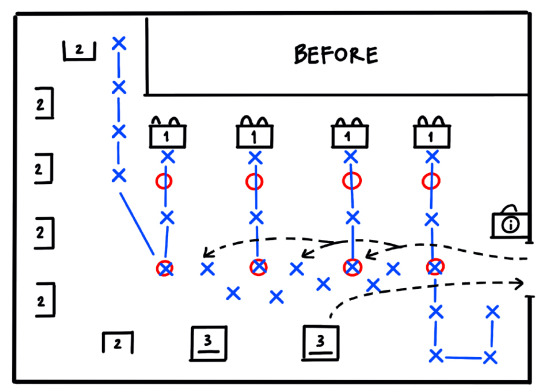
First wave (6-9am) There were three of us Line Managers and since none of us had ever done this before, we were just winging it. But by winging it, I also mean observing.
During setup, one of my teammates laid the floor markers as best he could -- one a few feet in front of each check-in desk and another six feet behind that, then a couple more near the entrance. An hour in, it was clear it wasn’t working. People were congregating around the stickers, blocking what should be a circulation path. A few people looked exasperated because they couldn’t figure out what the system was.
One table (the last one) was receiving a disproportionate number of voters. So one of the poll workers started a mini line just for that table that wrapped around the back of the room. We created a similar mini line for the next most popular table (the first one near the entrance).
My other teammate tried to get people out of the cold and in as quickly as possible by having them wait in an adjacent room. It quickly became clear that we needed to split up responsibilities.
Person 1 should greet people at the entrance and route them to the waiting area.
Person 2 manages the holding room, splitting them into lines depending on their district number.
Person 3 signals when the check-in desks can accommodate more people and for which district numbers.
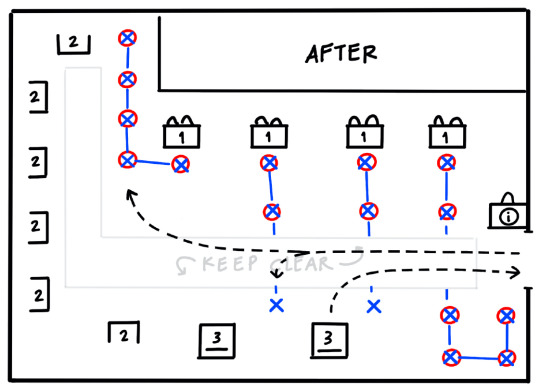
Second wave (11am-12pm) The only thing we couldn’t fix during the first wave were the sticker placements because people were standing on them. It seems like a small thing but it was really important and created a lot of chaos. Once the crowd died down, we worked quickly to adjust their placement.
We cleared the blocked circulation path of stickers.
We repositioned the two stickers closer to the desk. This made it so that the voter was standing on a sticker when it was their turn, while the next person in line six feet behind them standing on another sticker.
We added stickers where we needed mini lines for the first and fourth tables to make it easier to guide people there.
The new system worked like a charm! Seeing the next wave of voters come through was like pressing play and watching everything fall into place. It reminded me of that kitchen prototyping scene in The Founder about the story of McDonald’s.
If you’d like even more detail, you can check out the 2020 Poll Worker Manual.
0 notes
Text
My Poll Worker Experience (Part 1)
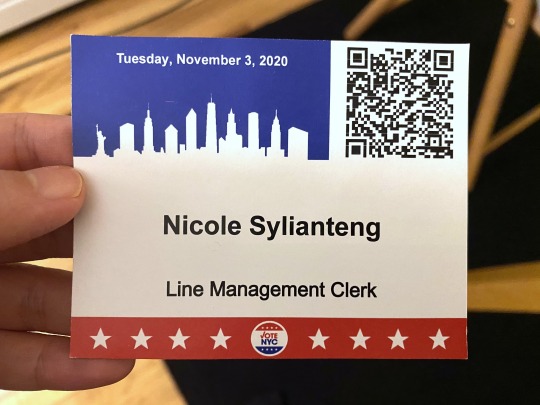
I worked as a poll worker on election day this year. I think one of the things that keeps people from getting involved in phone banking or poll working is not knowing what to expect. So I wanted to share how it works for those who are even the slightest bit curious.
I’ve broken it down into four parts:
Application - Filling out the application form on the BOE website.
Training - Everyone who applies is required to complete in-person or online training.
Assignment - Work day and role assignment.
Election day - The day/s that you have to report to work.
Application
I filled out a simple application form on the New York Board of Elections website. No cover letter necessary.
I picked the dates I was available so I picked November 3, 2020.
I then waited for my application to be reviewed and accepted.
Training
Once my application was accepted, I could click on the training link. I believe there’s a way to do this in person but I did it online.
It took me 6-8 hours to complete training. It was long! I did not expect that.
I was trained for every job (around seven) even though I was only assigned to one role. This might’ve been more useful had I signed up for several slots and different roles but I didn’t so I thought it was a waste of time. On the other hand, they probably also want you ready for whatever job they need you for.
Once complete, I waited for your job assignment.
Assignment
Three days later, I was assigned my job and location. I got Line Manager at a location 30 minutes away by car (Brownsville neighborhood) from 5am to 9pm.
I had no idea what a Line Manager does because it wasn’t included in the training and I didn’t know why! This made me nervous. I was scared that I was going to show up there not knowing what to do while everyone else did. In order to avoid this, I made sure to save a PDF of the poll workers manual on my phone. (Fast forward to election day: Everyone else who was new was also just winging it! Anyone who wasn’t busy could help out wherever.)
Election Day
We were asked to arrive 1 hour before the doors opened and stay until the polls close when our coordinator says we can go. I got there at 5am and left at 10pm.
There were about 15 other poll workers -- 4 veterans (middle aged women) and the rest new like me and on the younger side.
You get a two hour break in between and they encourage you to take the entire 2 hour block at once since it’s less disruptive.
We started packing up by 9pm and finally left by 10pm.
Five weeks later, I got a check in the mail for $350 (Net pay minus taxes $296.99).
Continue on to Part 2 for how my Line Management job went.
0 notes
Photo
i love this! she can make it into a vinyl decal.

I had the idea to create a drawing in the size of my bathroom tiles so that it looks like one of them is missing and reveals a creature lurking behind the wall.
358 notes
·
View notes
Photo

You know how people complain about the large gaps in American toilet stalls? This one isn’t like that. I wonder who makes these stalls - the gaps are pretty tight. This office space is designed by @fosterandpartners I believe. (at R/GA) https://www.instagram.com/nsylianteng/p/BvLWvJaFQ_j/?utm_source=ig_tumblr_share&igshid=8hnlj666g7wj
0 notes
Text
How to find a rent-stabilized apartment in NYC
A few months ago after much sleuthing, I found out that our apartment was rent-stabilized. You’d think finding out was straightforward but it’s not. Here’s what the entire process looks like.
1. Is my building rent-stabilized?
In the Rent Stabilized Building List section on the NYC Rent Guidelines Board website. There is a static PDF list per borough, arranged by zip code. The one for Brooklyn is 339 pages long, and out building was on it. But this only tells us that our building has at least one rent-stabilized unit. Next was to find out if our unit was rent-stabilized.

2. Is my unit rent-stabilized?
On the NYS Homes and Community Renewal page, there’s a link to ask a question about a rent-stabilized apartment. I entered our apartment information and was informed I would receive an answer in the mail.
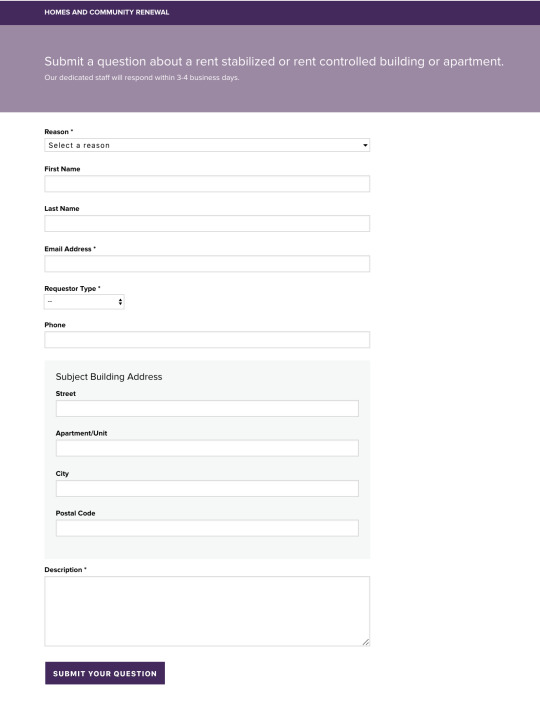
3. Your unit is rent-stabilized
The official report we got in the mail tells you if your unit is rent stabilized and gives you your unit’s rent history -- name of tenant, monthly rent, and whether it’s registered as RS, RC or something else.
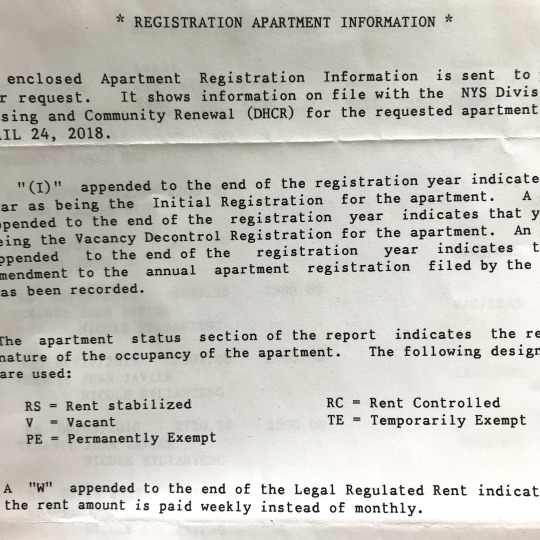
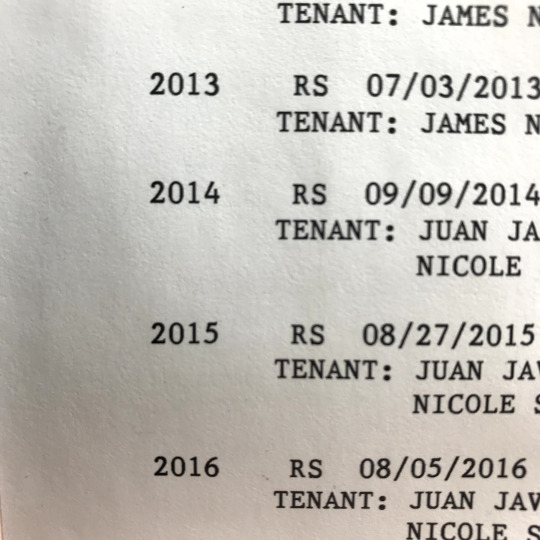
Here’s another person’s very involved hunt for a rent-stabilized apartment. You can also check if your apartment is rent-stabilized at amirentstabilized.com. Now what would be great is if there was a Chrome plug-in that popped up as you’re looking for apartments on StreetEasy...🤔
0 notes
Text
To Edlyn on her wedding day
For those who weren’t there, here’s the speech I gave at my dear friend @edlyn‘s wedding rehearsal dinner last month. @garychou suggested I share it here. It’s actually pretty good so I thought why not :)
Dear Edlyn,
I can’t believe it’s been 4 years since we first met. It was June 27, 2014 at the Orbital painting party, which was also the first time I met Jojo. You came up to me and asked what you could so. I gave you the paint, roller, and tray and basically said go to town! “But what do I do?” I was so confused about what there was to teach! *laughter*
Who knew we’d become such close friends to the point of having our own Slack group with Natalie? You always tell people about how I got you off the proverbial couch. I don’t say this often but in many ways, you’ve done the same for me.
Like the time you said “If you keep trying, you can only gain either mastery or resilience.”
Or that time I said “Someday, I want to be as unapologetically myself as the ageless and irreverent 96-yo Iris Apfel!” And you said “Why wait? Why not just be it today?”
You truly live like the world is your oyster, and with all your Edlynisms, inspire us to do the same. So thank you. For teaching me to ask for what I want, to never give up, and to always be unapologetically myself.
*toast* Here’s to you and Jojo on your wedding weekend and to your happily ever after.
0 notes
Photo

What makes safe streets (chapter 2, page 46) #readingjane https://www.instagram.com/p/BmY9hU_HB7W/?utm_source=ig_tumblr_share&igshid=6hvfbk9g29f9
0 notes
Video
tumblr
Who wants to read The Death and Life of Great American Cities with me? It’s a long book and I wanted to chip away at it chapter by chapter week after week. Sign up here: http://nikkisylianteng.com/reading-jane I’ve been going to Pilates 3 times a week and have been enjoying the routine of getting out early in the morning. So I wanted to try it for this book or else I’m just never going to finish it because there’s always going to be something more important.
3 notes
·
View notes
Text
Hey Google
I’m surprised by how much I love our Google Home. And how useless other people find it. Do they just not know about these amazing functions?, I wonder. Which leads to me furiously typing out all the ways I love using it. It’s happened enough times that I thought I should share it. You may find this relevant if you, like me:
Are easily distracted by your phone, and feel bad about it.
Remember important to-do’s throughout the day – usually while you’re busy with other things – and don’t want to forget. Remember important to-do’s throughout the day — usually while busy with other things, and want to get it done right now.
vimeo
Get cook time
Helpful for when I’m about to cook, food in hand, then remember that I have no idea how long to cook it for. Good for things like boiling eggs, cooking rice, steaming artichokes.
vimeo
Set timer
I use this the most when cooking and my hands are occupied and dirty. It’s especially useful when I’m cooking many dishes simultaneously because it can handle multiple timers.
vimeo
Check store hours
I do this mid-task when I suddenly remember that thing I need to buy but it’s five o’clock and I’m not sure if the store is still open.
vimeo
Call store
I use this to check stock at my local neighborhood shop, or call to see if a restaurant I’ve been meaning to try takes reservations. It’s like having an intercom to the world.
vimeo
Check weather (+ wind and humidity)
What I wear depends on the weather, which is more than just temperature. In the winter, wind speed tells you how much wind-chill there is (5-7 mph is the tipping point). In the summer, humidity level tells you how sticky it is (50% is the tipping point). Google Home is more nuanced in its weather reporting and is what led me to leave Alexa.
vimeo
Add to shopping list
My husband and I share a shopping list and add to it as we go about our day.
vimeo
Mental Math
I have many talents but mental math is not one of them. I remember crying in grade 2 because I couldn’t keep up with my classmates during a recitation session. With Google Home, I am handicapped no longer! I just rattle numbers off a page, and voila, I have the answer. This even beats using a calculator because I tend to lose my place as I switch between reading and punching in the numbers.
I used to think voice-controlled assistants were devices for tech fanatics who love technology for technology’s sake. But after living with one for six months, I think the opposite is true. They’re for people who want to get away from their phones, who want their lives to be at the foreground quietly supported by technology in the background. At least that’s what it does for me.
0 notes
Quote
The most important title is not 'president' or 'prime minister'; the most important title is 'citizen.'
Barack Obama
0 notes
Photo

A subway wish inspired by @lukew's "What Would Augment Reality?" (at MTA-Carroll St)
0 notes
Video
instagram
Wondering if I should add this to cityobjects.io. ha what if it's just reusing the plastic covering? (at Chicago O'Hare International Airport)
0 notes
Text
What I Learned From Hamilton
I went to school in the Philippines so we never learned about American history per se. And what we did learn was always in the context of the Philippines, which was America as the Big Brother colonizer. Hamilton gave me a new perspective on America. Here’s what I learned.
Hamilton told the story of America when it was still under British rule and how they revolted against this. I realized that Americans were European rebels.
Hamilton showed America as a startup and with its founders figuring stuff out as they went along. Having to figure out things like, what it means to start a new country? What do we stand for? How do we formalize this?
I learned that New York was once the capital before it was traded for D.C. in exchange for the government assuming the states’ war debts.
Hamilton is an origin story. I love origin stories because it gives insight and context into why things are the way they are. Over time, this can get complicated and muddled, but going back to when it all started zeroes in on original intent and how that’s evolved or stayed the same over time.
I learned that America was always divided, and things just never got resolved. This made me feel better since I used to think we were once united then became divided which made me want to figure out where we went wrong. But actually, there were always two visions of America. We’re having the same conversations now as we did then, except now it’s more polarized.
I didn’t know that George Washington could’ve stayed in power forever like a king, but chose not to. He set the precedent for the term limit in American politics.
1 note
·
View note